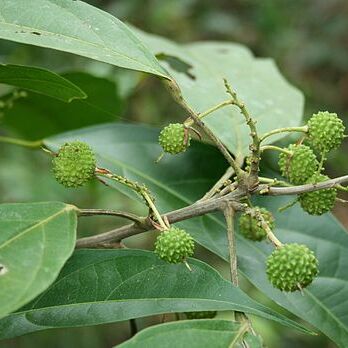Shrubs or trees. Leaves persistent or deciduous, alternate, subentire or generally dentate, penninerved, ± long-petiolate, stipulate. Flowers bisexual or ♂ by abortion, in axillary racemes or panicles, rarely reduced to a solitary flower. Sepals (2 or) 3, imbricate, concave, caducous. Petals 6–12, imbricate, slightly longer than the sepals, white, caducous. Stamens indefinite; filaments slender, free or rarely conglutinate below; anthers linear, opening lengthwise. Ovary sometimes shortly stalked, smooth, tuberculate-muriculate or shortly echinate, 1-locular, with 3 (or 4) few-to multi-ovulate placentas; style filiform, entire or rarely shortly divided. Capsule woody, with short obtuse emergences or with spines, tardily dehiscent into 3 (or 4) valves. Seeds 1–3, rarely more, mutually compressed, partly covered with a red aril, with copious endosperm.
Ovary shortly stalked, smooth, tuberculate or shortly echinate, usually hairy, 1-locular with 3 parietal placentas; placentas multiovulate or with relatively few ovules; style simple with inconspicuous stigmas.
Leaves petiolate, petioles sometimes elongate; lamina usually rather large, glabrous or hairy, hairs stellate or simple, margins usually toothed.
Fruit a globose, woody, echinate or warted capsule dehiscing tardily into 3 longitudinal valves.
Seeds 1–3, with copious endosperm and a large embryo with flat, cordate cotyledons.
Stamens co, filaments slender, free or rarely connate in a tube; anthers linear.
Flowers bisexual or male by abortion, in racemes or solitary in the axils.
Petals 6–12, imbricate, not much longer than the sepals.
Sepals 3, imbricate, concave.
Unarmed shrubs or trees.
Stipules present.

